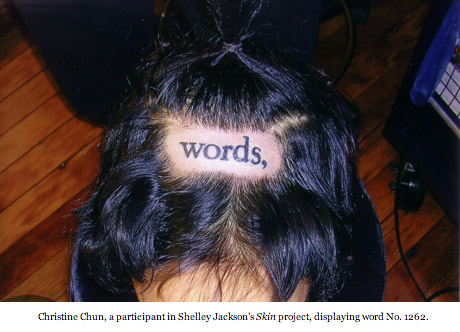“I’ll tell you this, lad: A tattoo says more of a fellow looking at it than it can do of the man who’s got it on his back.”
—Sarah Hall, The Electric Michelangelo
“It’s only his outside; a man can be honest in any sort of skin.”
—Herman Melville, Moby-Dick
In 2003, the author Shelley Jackson announced that she would publish a 2,095-word short story called “Skin” on participants who agree to be tattooed with randomly assigned words from her text. The tattooees alone will read the story, which will be complete when the last commissioned word is inscribed on its bearer, sometime in the next few years. It will not be published on paper. Jackson asks applicants (she has many more than she can use) to read her novel, The Melancholy of Anatomy, to ensure that they like her writing before committing to a word, because “Skin” is what she calls a “hidden track” (in the pop-music sense) of the book; both explore the relationship between words and the body.
Jackson’s project, commissioned by Cabinet magazine, is a dramatic act of literary deconstruction—it pushes her words off the printed page onto the living body, marrying the reader and the text, the symbol and the narrative, not to mention visual art and fiction. Not surprisingly, her volunteers are both students and professors of literature, as well as artists, graphic designers and typographers. She also has mother-daughter teams, friends who want to become a phrase or a sentence, a private investigator, a zookeeper, and a specialist in glaciers. One participant is a book collector who saw the project as an opportunity to collect a rare manuscript. Another liked the notion of “a text written on bodies and the idea that the text would encounter erasure with death and time.”
Subversive as it is, “Skin” is rooted in a rich tradition of tattoo symbolism in American literature. We have Hawthorne and Melville to thank for drafting the dual designs—one personal and iconic, the other cultural and narrative—that have shaped tattoo imagery in American fiction. The Scarlet Letter (1850) and Moby-Dick (1851), those twin towers of prototypical symbolic lit, were published just as marked bodies began landing on the shores of American consciousness, soon after tattooed oddities and tattoo artists began plying their trade on the East Coast, and immediately before our nation’s first tattooed white woman, Olive Oatman, was released in California after four years’ captivity with Mojave Indians. Oatman was “repatriated” (probably against her will) in 1856 and resurfaced wearing a tribal tattoo on her chin, which riveted the American public.1
*
A Victorian savage was something to...
You have reached your article limit
Sign up for a digital subscription and continue reading all new issues, plus our entire archives, for just $1.50/month.
Already a subscriber? Sign in





